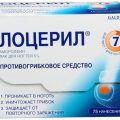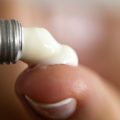What is mildew and what it is
Disease "powdery mildew" on cucumbers, as well as other plant species, always caused by fungal infection.
True mildew, which looks like a white or gray coating on plant leaves, wonderful feeling and actively develops subject to the determination of relatively cool temperatures and increased humidity.
The other kind of fungus - so-called "downy mildew" on cucumbers and other horticultural cultures also develops when wet weather condition, but most of all plants subject to LRM with warm temperatures, especially if, when diurnal temperature differentials of the order 10 degrees Celsius. plant Photos, LMR affected in a greenhouse:
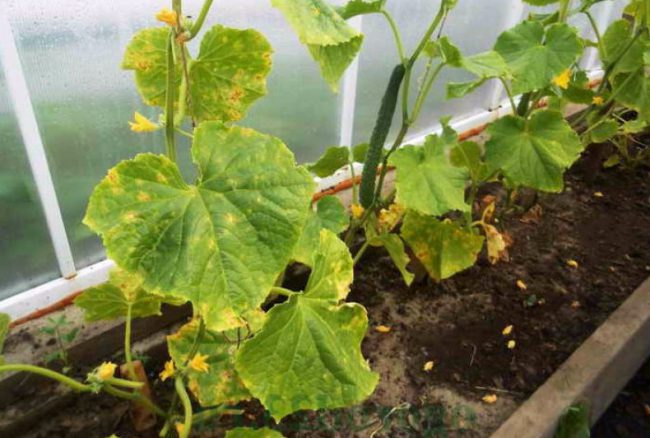
Often, the disease develops in the greenhouses of cucumber, since growing cucumbers in the greenhouse and the greenhouse temperature differences at the opening on ventilation are common. Like mildew and overcrowding - too dense planting with a chance to "catch" an insidious fungus significantly increased, and the time of its distribution - is greatly reduced.
so, if your green wards suddenly somehow there were white spots, and the leaves start to curl and wither - likely, This is powdery mildew attack your vegetable crops. Pathogenic microscopic fungus attacks the plant cells, and then in them during the incubation period of 3-5 days the mycelium is formed, after which the first symptoms.
Important! Fungal spores usually enter the plant from last year's dry leaves. Therefore, preventive spring cleaning plays a very important role in preventing the spread of the pathogen on the plot. Prevent - so you do not have to be treated!
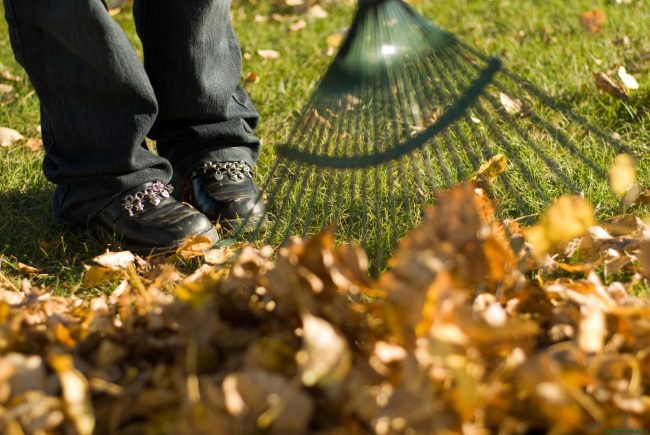
Cucumbers suffer from powdery mildew is not only externally. Fungal attack the plant stops growing, does not develop, he shoots wither and die, zavyazi, flowers and fruits rot and blacken, joins secondary pathogenic microflora, eg, rot. And fast enough, if you do not take any adequate measures to combat this disease of cucumber, the untreated disease affects all plants, then even getting the minimum harvest tiny cucumbers becomes quite unlikely.
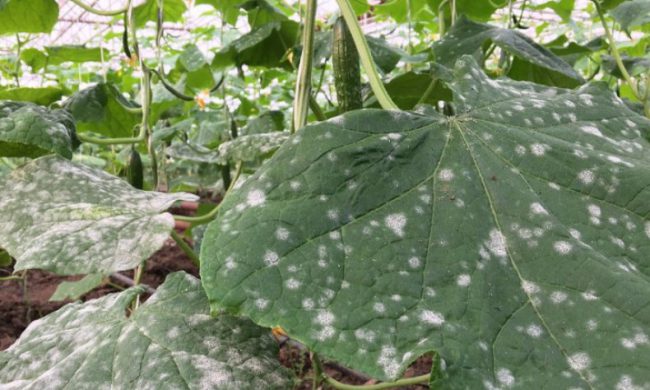
It is interesting! In people, symptoms on leaves, resembling flour, also called "underwear" or "pepelitsey" for similar associations.
Symptomatology of the disease, and
Infection mildew is typical for the beginning of summer, at this time it is often replaced by the first heat of the arrival time of the rains, and the temporary, but quite cold snap. Main, the first and most characteristic sign of infection with a cucumber vine mildew is the emergence of a kind of raid (whitish, gray or yellowish), which initially is localized mainly on the lower leaves and young shoots of cucumber. Besides, if you look, it can be seen on the leaves brown tiny spherical point - spores of the pathogen of the disease.
After that, the data spores ripen, plaque covered with droplets of moisture, hence the word "dew" in the name of the disease. If you leave our patients without green sprinkles and treat infected plants preparations of powdery mildew, the disease progresses. plaque is sealed, It becomes brownish and, rising up, It captures the whole plant is fully, including leaves, flowers, fruits and stems. At the same time, the fungus affects the neighboring plants, and the disease spreads faster, the denser the area planted seedlings and more than bladgopriyatnye environmental conditions "provided" fungus. Sluggish and weak infected cucumbers gradually die, failing to bring the long-awaited harvest.
It is interesting! Powdery mildew completely non-species, it is the same "hunting" hits and cucumbers, and fruit trees, and berry bushes, and even cereals. Worldwide breeders are constantly working on breeding new varieties of various plants, resistant to defeat this type of fungus.
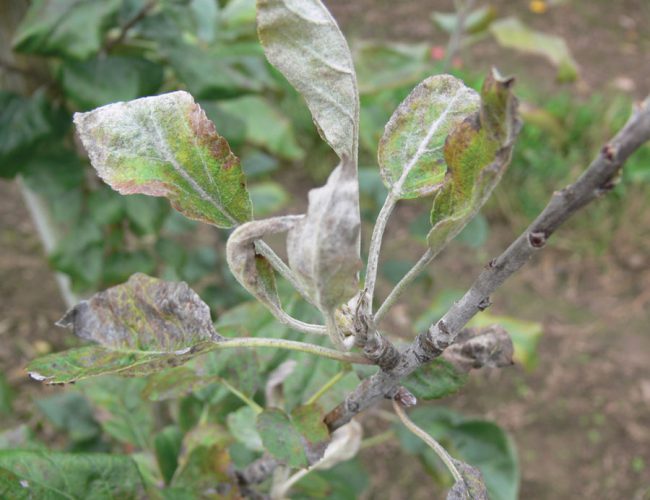
How to defeat the enemy, prevention
note! Downy mildew is able to maintain absolute viability in the soil for up to 6 years old!
Faster and most actively mildew, and downy develop in conditions waterlogging and condensate accumulation, in the absence of ventilation and when grown in the shade. Night cucumbers should be well cover or provide them with heating in order to avoid temperature extremes.
While cucumber seedlings had not yet attacked the downy, for prevention and for the health and plant immunity as a whole experienced gardeners carry out a series of special events.
note! preventive measures, like all folk remedies to combat powdery mildew on cucumber and downy perfect like the appearance of the first symptoms of the disease, and with extensive infection as part of comprehensive measures in the event, when the fruits already formed. Processing chemicals cucumber admissible strictly prior fruiting, and ideally - before flowering.
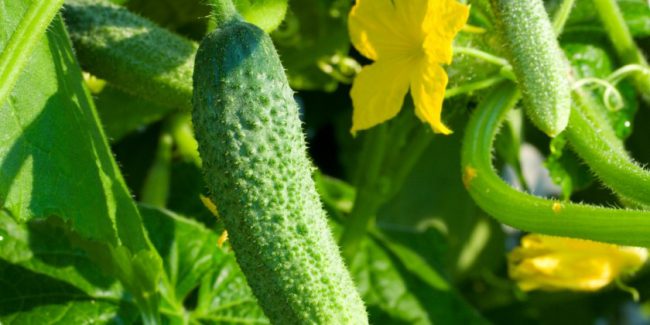
Of course, much easier to warn in advance the defeat of plants downy mildew, later than long time to heal diseased cucumbers and reap the benefits of the raging disease. Timely detection of disease, you also significantly increases their chances of victory over him.
so, it is important for the prevention of infection:
- Every fall deeply dig the beds and remove all the weeds and plant residues. Spring cleaning is repeated;
- Irrigate only warm water in the morning, that the plants have time to soak up the moisture before the evening cooling;
- To maintain the temperature in a greenhouse or a greenhouse at about the same level in the daytime and nighttime, avoiding sudden drops her. During the day the plants will feel well at about 25 degrees Celsius, at night the same time, the thermometer should be on the mark within 18-21 degrees;
- Should abide by the rules of crop rotation, that is not planted in the same place the same (or similar) culture each year;
- Feed the plant phosphorus and potassium fertilizers, which considerably increase resistance to defeat both kinds of "dew";
- Often produce ventilation;
- The simplest thing - to plant the plants resistant to fungal attack varieties. We worked well in this regard hybrids: Delpina F1, Vicenta Anuta F1 and F1.
- If you choose a high-quality plant, not possessing high resistance, directly in front of the seed soak sowing in the classical solution of potassium permanganate - dark potassium permanganate solution is well suited for decontamination.
- What to do at the first sign of defeat? - Spare no, to uproot and burn diseased stems and leaves, otherwise, then you have to feel sorry for all the plants and a wasted effort.
- In the early stages of formation of the plants, namely, even if the growth of young seedlings, use of iodine solution becomes a base for formation of an increased resistance of plants to fungal and other diseases. It is important not to oversaturate solution, not to burn the young plants: for every 3 a liter of water is added only to 1 iodine drop. After thorough mixing, the resulting solution is made root watering. Such processing is carried out once.
Treatment
When choosing a method of treatment of already infected plants, Pay special attention to the period, when the signs of destruction had an effect. This will depend on the, how to deal with mildew on cucumbers, some of the numerous methods for combating infection choose.
When selecting the treatment methods is of great importance during infection. If your plants slightly amazed, i.e, on the leaves of cucumber in a few places in the bottom of the vines are seen 2-3 speck, while your green friends have already entered the phase of fruiting, It can in some cases do folk remedies. Of course, affected leaves must be mechanically removed.
If extensive lesions and ovaries until the permitted use of chemicals.
Important! Before starting treatment should stop making dressings, remove all the affected parts of the vine (carefully inspect not only the leaves, but also the stems, and flower stalks) and as much as possible to thin out the landing.
Traditional methods
- From folk remedies for treatment of powdery mildew ridges diluted mullein considered sufficiently effective. Cow manure in the ratio 1:3 diluted with water, then the solution was infused for 2 day, repeat breeding infusion 1:3 with water, filter and produce spraying ridges. It should be sprayed as the plant itself, and land.
- Effective means believe in the people and the infusion of marigold. To prepare it, take a bucket ½ finely chopped flowers and fill them with warm water, then insist 2 day.
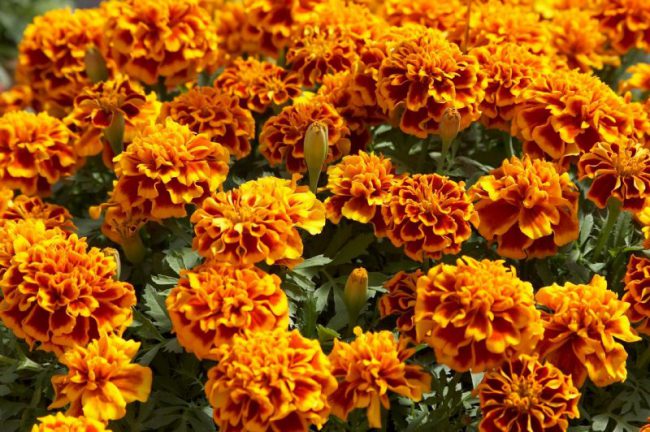
Infusion of marigold plants should be treated several times, and such spraying repeated weekly Then make filtering, was added and dissolved in the resulting liquid 40-50 g grated soap or liquid tar and also treated by means of spraying, not only affected, but healthy plants. It is not only a means to sprinkle on the ailing vine, but also possible to prevent the spread of the infectious agent. Treat the plants several times, such spraying can be repeated weekly.
- Very simple to prepare and thus it is an effective means of solution with milk and iodine. In addition to the antifungal effect, processing iodine solution promotes healing of minor damage to the plant and increase their productivity. On 1 ml iodine (You can measure medical syringe, in no case to raise the recommended dose) taken 1 l whey or skim milk and is insoluble in all 9 liters of water. The solution is easy to cook in a bucket. After thorough mixing of all components in solution was added tablespoon of liquid soap or tar rubbed 40 gr economic and dissolved until smooth. Such spraying can be repeated 1 every 14 days.
biological fungicides
Such funds are safe, because they are non-toxic to humans and warm-blooded animal organism. They are approved for use including during fruit formation, and, of course, This fact makes this category of drugs are very popular among gardeners. And the greatest love among the home-grown vegetables and fruits lovers won the following drugs:
- "Fitosporin-M". according to the instructions 6-10 g dry agent is diluted in a bucket of water, tool used for spraying. The drug loses its effectiveness in sunlight, therefore, treatment should be carried out on a cloudy day or in the evening.
- "Psevdobakterin-2",
- Planriz ',
- Gamair ',
- Alirin.
These means to combat powdery mildew and other diseases can be purchased at specialty stores. Apply them should be strictly according to instructions, regardless of their security in general.
Chemicals
undoubtedly, are the most effective drugs of all groups of, but, they are toxic and are not safe and should not be used after, as the plants come into bloom period.
Plants often treated with drugs:
chemical mixture "Topaz" (It is considered to be a very effective tool), "Fundazim", quite popular with gardeners 'soon', good old bluestone, 'Baylé, Fundazol ', «Tiovit». Processing their crops experienced gardeners spend also such lesser-known, but it is very effective means, as "Quadris", "Topsin" and spray liquid "Tittle".



